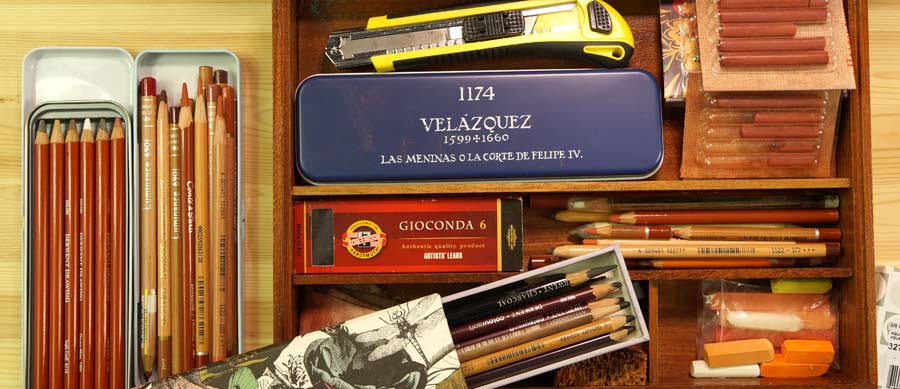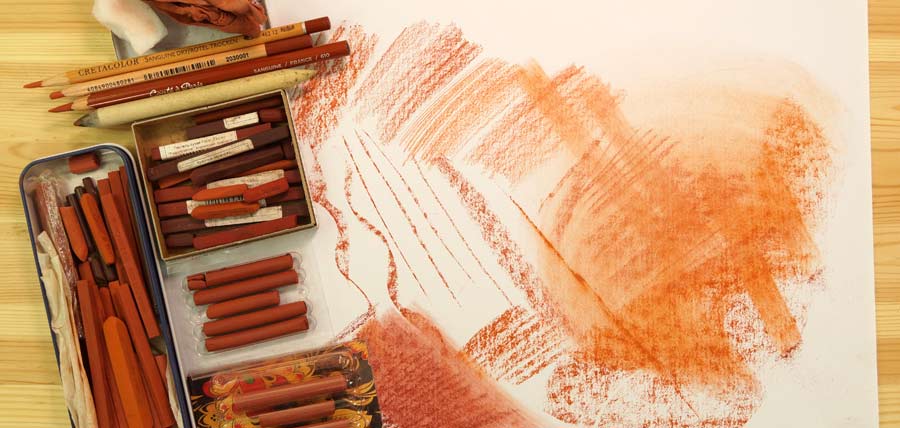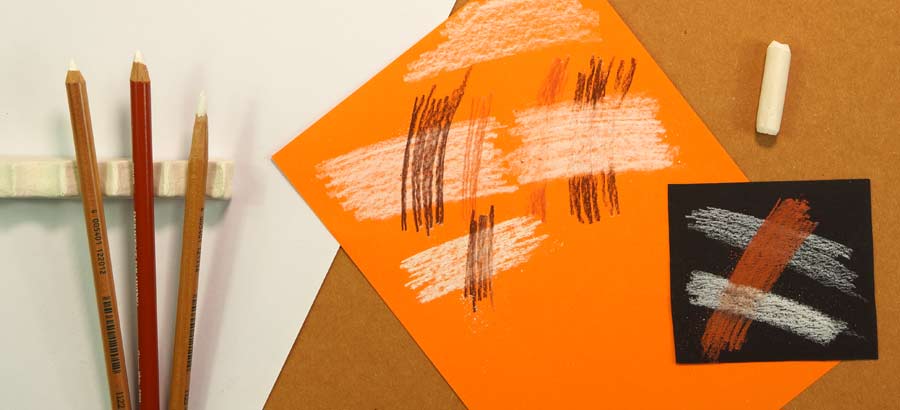Drawing Materials
This is your unique chance to get a lifetime academy membership and a dedicated team of art teachers.
Such unlimited personal tutoring is not available anywhere else.
Enroll in the Life Drawing Academy now!
Materials for Life Drawing
In this video lesson, you will learn what drawing materials you will need to fully benefit from this course. In the Life Drawing Class, you will see how to draw models with graphite pencils and soft drawing materials such as sanguine and chalks. The shopping list of materials is quite simple and very affordable. Here's what you will need:
Drawing paper
If you are serious about improving your life drawing skills, get good quality drawing paper. Any reputable brand will do. Get at least A2 size or bigger. To save on cost, you may buy a roll and cut sheets in the size required. Make sure your paper has sufficient weight—200gsm or heavier. Also, pay attention to paper tooth. Paper for graphite artworks can be smoother, but for soft materials like sanguine or charcoal, it is good to have a bit coarser tooth that dust particles can hold to. White wood pulp Ph-neutral or acid-free paper is good for your disposable works. For museum-quality drawings, you may decide to use 100% cotton archival quality paper; that comes at a cost but will survive many hundreds of years when stored properly.
Sketchbooks are optional. If you have one, use it for taking notes about anatomy, sequential steps of life drawing, and body proportions as you watch the course videos.
The aim of this course is to give you a solid knowledge of life drawing, so practice drawing using big paper. Going small will be easy after you've done big-scale studies.
Graphite pencils
Graphite pencils are another must-have material. For practicing purposes, two grades will fit all your needs—HB and 2B or 3B. It is an amateur misconception that you need the full range or some five grades of graphite softness. It will be better for your drawing skills to learn how to achieve a wide range of tonal values using just two or three pencil grades. Changing softness grade for small gradations in value is like changing a car engine every time you want to go faster or slower. You learn how to vary pressure on an accelerator pedal, and you'll do likewise with the pressure on pencil.

There are so many pencil brands; go for any good name. All graphite pencils make marks on paper.
A pencil knife and pencil extender
Get a sharp pencil knife, craft knife, or scalpel and learn how to use them to sharpen pencils properly. Pencil sharpeners are only good for children for safety reasons.
Sharpen a pencil to expose at least 8 millimeters (one-third of an inch) of lead and 12 millimeters (half an inch) of wooden cone; after that, sharpen the lead point with sandpaper.
To save time when drawing, pre-sharpen several pencils at once and change them as often as needed when working, keeping the pencil-tip sharp at all times.
Also, you may want to buy a pencil extender so you can use well-sharpened pencils to the very end.
Erasers
A couple of erasers will cover all your needs—a rubber one and soft, kneaded eraser.
To make a rubber eraser more pointed, you can cut it in half diagonally. Pointed corners are handy when you work on small details.
Drawing board
Another good-to-have item is a drawing board. If you don't have one, check your local building materials shop; most likely you will find a big, smooth board without paying art shops' premiums. The board should be at least A1 size, and you can fix paper to it using masking tape.
A drawing easel is totally optional; it is good for working when standing. If you don't have one, adopt a sitting position. You can place a drawing board on a chair and sit in front of it. The board should be positioned almost vertically at your chest level, perpendicular to your sight-line, at an arm's distance, and be in your field of view together with the model.
Sanguine, charcoal, colored pencils, and chalks
Now we can say a few words about optional extras.

If you don't have strong life drawing skills yet, I would advise drawing with graphite pencils for as long as you learn, without going for sanguine, chalks, or colored pencils.
Here's the truth they don't teach in contemporary art colleges: sanguine comes with natural red color that looks appealing in figurative artworks. Because of that, drawing mistakes are more difficult to spot, and without seeing mistakes, you can't fix errors and learn how to avoid them. So your learning curve becomes longer, education more difficult, and results not as you'd intended.
Charcoal sticks, carbon pencils, and similar materials give deep black tones. They are easier to apply and erase, and therefore they seem to be a good fit for life drawing, or so it's thought in art colleges. Here's the downside of charcoal: expressive life drawing is only good when supported by strong knowledge of proportions, constructive drawing, and anatomy. Obtaining such knowledge requires precision in drawing, not expressive smearing of black dust on paper. Good drawing skills are also based on your ability to make high quality lines. You will obtain these skills only by drawing lines for hundreds of hours. For that reason, I would advise using a more precise and "disciplined" medium—graphite.

However, if you have advanced drawing skills, have spent thousands of hours and done hundreds of life drawings, know human body proportions, anatomy, and constructive drawing sequence, your next step would be to work on your creative tasks, where soft drawing materials will help to express what you have to say in life drawing. If this applies to you, you probably already know enough about such media. Anyway, I will briefly cover those materials.
Charcoal comes in chunks, sticks, and pencils in several softness grades. It's quite messy, easy to smudge, and charcoal drawings need to be fixed with a fixative before storing. Paper for artworks in charcoal has to have a sufficient tooth to hold particles of charcoal dust.
Sanguine is also available as sticks and pencils; its color can vary from one manufacturer to another. The composition of the clay makes various types of sanguine feel different on paper. There are no right or wrong types of sanguine. It is really down to personal preferences and creative tasks you may have. Depending on your personal preferences, you may like working with sanguine pencils that won't stain your hands, or with sticks that can be applied sideways, making the range of marks much wider and more expressive. The same can be said about colored pencils and chalks like pastel.
If you work on toned paper, you may also consider a white chalk or pencil to make highlights in your artworks.
Keep in mind that some white and colored pencils have waxy content in the leads, which makes them difficult to erase. Also, chalky drawing materials do not grip on top of such waxy lines, which makes mixing of two media in one artwork more challenging.

The purpose of this course is to give you good knowledge of life drawing fundamentals, not how to be expressive with mixed media, so let's progress to the main objective.
One final word about drawing materials: we do not promote any brands or manufacturers. Any high-quality, artist-grade materials will suit for your educational purposes. Do not sabotage yourself by looking for a particular pencil, paper, or drawing easel instead of actually practicing drawing. Also, we won't support your procrastination by getting involved in "what pencil should I buy?" kind of questions. Get some and start drawing. Human body proportions, anatomy, and constructive drawing principles will remain the same no matter what brand of sanguine or paper you have. Trust me, it is not about materials but skills. Skills cannot be purchased, only obtained by learning and practicing.
[ The full lesson is avaibale to Life Drawing Academy members ]
This is your unique chance to get a lifetime academy membership and a dedicated team of art teachers.
Such unlimited personal tutoring is not available anywhere else.




